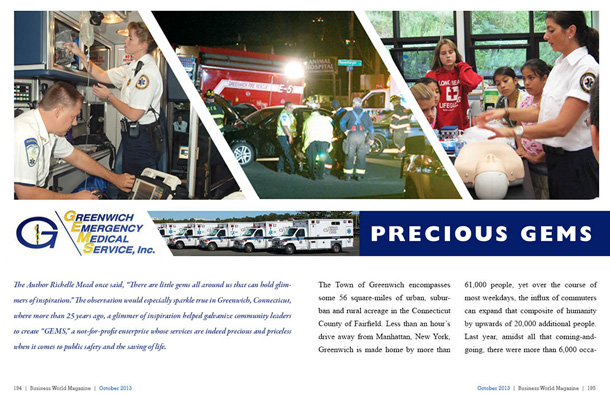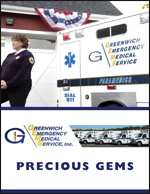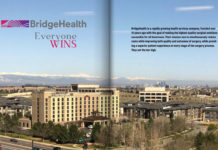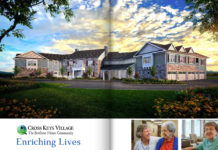
Precious GEMS

The Author Richelle Mead once said, “There are little gems all around us that can hold glimmers of inspiration.†The observation would especially sparkle true in Greenwich, Connecticut, where more than 25 years ago, a glimmer of inspiration helped galvanize community leaders to create “GEMS,†a not-for-profit enterprise whose services are indeed precious and priceless when it comes to public safety and the saving of life.
The Town of Greenwich encompasses some 56 square-miles of urban, suburban and rural acreage in the Connecticut County of Fairfield. Less than an hour’s drive away from Manhattan, New York, Greenwich is made home by more than 61,000 people, yet over the course of most weekdays, the influx of commuters can expand that composite of humanity by upwards of 20,000 additional people. Last year, amidst all that coming-and-going, there were more than 6,000 occasions where a traffic accident, or a heart attack, or some other dire or dangerous physical impact prompted a 9-1-1 call and the urgent dispatch of those who truly stand out as some of the most stellar professionals serving in emergency medical services today. Greenwich Emergency Medical Services, or GEMS, is a not-for-profit, sole provider of advanced life support emergency services to the people of Greenwich. Throughout the 27 years of its operation, numerous lives have not only been saved from death, but spared from greater physical impact which may have otherwise resulted from their injuries due in large credit to the speed, expertise and quality in the care imparted by these emergency responders. GEMS is a national leader in “cardiac save rates†which annually figures between 35 to 40%, yet is a remarkable 55% this year (more than three times better than the national average). This means that after EMS responded to a patient enduring cardiac arrest, in more than half of those encounters, the patient fully recovered, neurologically intact. GEMS Executive Director Charlee Tufts attributes that achievement to not only the excellent training and material equipping of staff, but also the ingenuity in the way GEMS deploys its services. GEMS operates from four stations strategically located following intensive call-density studies that helped identify areas where the greatest needs existed. Tufts explains that GEMS personnel also adhere to a shifting pattern; a process wherein as soon as the “Medic-One†unit is dispatched to a call, the second unit will go into immediate standby, within their respective vehicle, to be fully, efficiently prepared for the second call, and should it come, a third unit then goes into ready mode. Its positioning and shift patterns has helped generate emergency response times of under five minutes for more than 70% of Greenwich residents, and below eight minutes for 96% percent of the community. And while GEMS has saved lives while fulfilling its mission to provide the highest quality of pre-hospital care for the people it serves, it has also helped save Greenwich millions of dollars as an autonomous, not-for-profit who is contracted by the town, and eligible to conduct fund raising activities congruent with community needs.
A GEM of a Good Idea
Prior to the establishing of GEMS, Greenwich had six separate “priority†units which could provide basic, but not advanced life support services Four of these units were interspersed among volunteer fire departments, while another one was stationed with the police department and the last was located “in a lady’s backyard,†says Tufts. “These priority units didn’t communicate with each other, didn’t train with each other and the level of service a patient would receive was totally dependent on who responded to the call first.â€
Tufts, a critical care nurse with experience in hospital emergency room as well as pediatric intensive care, had moved to Greenwich in 1974. During the course of fulfilling her nursing duties, she says there were encounters which left her with the conviction that more could have been done to help the patients before they were admitted to the hospital. “I sensed that we could do more in the field … services could be more than a scoop and run,†says Tufts. That belief was strengthened after Tufts began volunteering with a fire department at Sound Beach in Old Greenwich. She loved working in the field, but she also grew to especially appreciate and respect the people with which she worked, who often tended to her young son and daughter right there in the station whenever Tufts would respond to an emergency call. In time, Tufts resolved to help the community transition from basic to advanced life support services rendered from a fully capable team of dedicated and credentialed EMS professionals. She found the idea had support from both the area hospital as well as the Department of Health. She also acknowledges that she was too young to know what the hurdles would be and the fact remains there was also some resistance. Despite the erratic level of service, frequently slow response times and areas that lacked service by being deemed inaccessible, there were some in the community who didn’t believe there was a need to invest in a professional EMS enterprise. Greenwich has what is known as a Board of Estimate & Taxation which is responsible for administration of financial affairs. The BET included such men as Chairman Sam Stowell and Members Richard Kriskey, Frank Mazza and John Raben. Their support proved crucial to allaying criticism from detractors. An advisory group comprised by representatives from the police and fire departments, hospital and other stakeholders also helped outline operational strategies and GEMS ultimately secured operational approval, funded through a combination of public and private dollars. “We were formed as a not-for-profit because the town didn’t want to take on another employee group … and it was so unknown at the time, it helped ease concerns about liability and legal issues too,†explains Tufts.
For whatever confusion or concern that was prompted by GEMS start, it has since been replaced with pride and respect, for time and time again, this team of professionals has proven to be the difference between life and death. Tufts says GEMS is “very selective†when it comes to choosing staff, and she credits GEMS industry distinction to the dedication, discipline and devotion of a team that doesn’t simply approach their fulfilling of duty in career terms, but something closer to a life’s calling to help and serve others. Tufts says some GEMS personnel have been there since the very inception of the service, and among the volunteer component, there are some who’ve been so committed as to advance their training to the level of paramedic.
More than Emergency Dispatch
GEMS has also sparkled as a provider of EMS training, not only critical to its own staff, but those in who serve in the fire department, those who serve with the police force (who also responds to every 9-1-1 call) and literally thousands of community residents which includes area school children. What began as a first aid program benefitting area third graders has now grown into an education curriculum that serves students from grades 6 to 12; teaching them not only first aid, but also CPR and college prep health and safety courses. An intern program routinely facilitates volunteers from high schools who assist in GEMS standby duties during community events and have the opportunity to gain the credentials to actually ride along during emergency calls. Tufts says the program has helped students garner greater awareness of career possibilities, but make no mistake, this program has also helped save lives. In the recent case of one family, an Uncle had come to visit and went into cardiac arrest, two children who had completed GEMS’ CPR training, administered treatment and saved the man’s life.
GEMS has also been instrumental in the distribution of Automated External Defibrillators (AEDS) which can be found among area schools, libraries, gyms and beaches, readily accessible for use should a need ever arise. The police have also been equipped with these live-saving tools to complement the EMT training they are mandated to undertake, but as Tufts says, “The police here are integral partners of our service, and they appreciate being able to help in a cardiac arrest beyond the other kind of arrests they deal with.â€
But with respect to the range of training and accessibility to AEDS and autopulse mechanisms, Greenwich has secured distinction as one of the most “HeartSafe†of American cities, and was the very first in Connecticut to be so esteemed.
The Future of GEMS
Tufts says community outreach will continue to represent an important function of GEMS, beyond its ongoing responding to 9-1-1 emergencies, training initiatives and the standby duties it fulfills at events and civic gatherings. That outreach will soon include increased emphasis on messages about the value of services provided by GEMS. Yet to be sure, that messaging has less to do with promotion, but more in the way of attracting philanthropic support. As a not-for-profit, GEMS relies on support from donors to complement what it collects from patient revenues, training fees and the appropriation it receives from the town. Donor contributions are solely used to support GEMS capital expenses, and for an example of such costs, Tufts explains that a typical ambulance can cost more than $200,000. She also affirms that GEMS’ Board of Directors fulfills a vital fiduciary role to the service, particularly in the area of capital fund raising. The board consists of more than two dozen highly respected Greenwich residents and four ex-officio in the First Selectman, the Director of Health, the President of Greenwich Hospital and a representative of the Greenwich Medical Society. The securing of funds has enabled GEMS to be very progressive in providing medical care. As Tufts explains, “Through capital fund raising, we can advance immediately when studies are completed showing the efficacy of numerous advanced treatments, such as in 1995 when we were the first in the northeast to add the 12-lead EKG capability, which for patients, meant decreasing the time to receive vital care by thirty-five to forty-five minutes. The funding also helped in 1997 when GEMS equipped every police car and marine unit with Automatic External Defibrillators, as well as a few years ago when we implemented induced hypothermia care for cardiac arrest victims … these initiatives have factored in our outstanding cardiac arrest save rates.â€
There are still challenges that GEMS is striving to overcome. Adequate training facilities, additional headquarters space and proper garaging of fleet are identified as GEMS greatest needs. At present, only one of GEMS four locations has true garaging in a structure that was rehabbed by the town. In the case of the other three locations, ambulances are exposed to the elements. State mandates require that the ambient temperature be maintained at 70 degrees. Therefore, in the winter, crews have to keep the engines running with the heat turned-on and do the same in the summer with the air conditioner, even though the ambulance isn’t being used at the moment. The constant running wears on the engines, ultimately shortening the lifespan of the vehicles, creating additional costs in fuel and environmental burdens from emissions. Tufts says proper garaging would mitigate those factors. Through its contract with the town, garaging is supposed to be provided, but has simply yet to happen.
In regards to larger facility space, Tufts says GEMS could provide greater training services which are now a challenge within the space they currently occupy. With additional room, GEMS could not only expand its training programs, but also secure recognition as a state-assigned testing site; either would enable the service to expand on its revenue base. The better care of its material resources and greater room to shine – that’s all a gem could want. Tufts says GEMS is preparing to launch a campaign that hopes to raise $10 million to accomplish these goals, and is generally optimistic that donors in Greenwich will rise to the occasion. Unlike 27 years ago, Tufts says many not only better understand the importance of EMS, but are fully cognizant of the quality, commitment and care devoted by GEMS. Her team is striving to create further awareness. “EMS is a critical service, but sometimes, there are still those who never really think about it until they dial 9-1-1, and often, they don’t even think to dial 9-1-1 when they should. We represent the third arm of public safety … our services are just as important as that provided by police or fire… and we save lives.â€
For more information, please visit their website at: Â Â Greenwich Emergency Medical Services
Preferred Vendors of Choice:
- EF&RÂ








ghgh
Comments are closed.